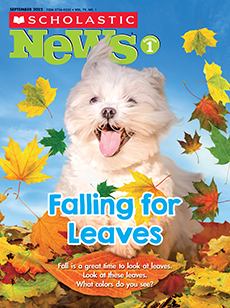A guide for using our resources
Students will identify and use words to describe pumpkins.
Vocabulary: texture, wide, rot, hollow
Science Focus: plants
CCSS (and states that have similar standards): RI.1.1 key details; RF.1.3 phonics and word analysis; SL.1.1 collaborative conversations; L.1.2 standard English capitalization, punctuation, and spelling; RL.1.1 key details; W.1.8 answer questions
Simple, spectacular ideas to boost your lessons.
Paired Text: How Big Could Your Pumpkin Grow? by Wendell Minor
Paired Text: How Big Could Your Pumpkin Grow? by Wendell Minor
- Grow children’s vocabulary and imaginations with this adorable book! It takes you on a trip to see pumpkins across the country, teaching big new words along the way. Kids will love envisioning the size of these larger-than-life pumpkins.
Class Brainstorm: Antonyms
Class Brainstorm: Antonyms
- Tell children that the article has a lot of antonyms.
- Explain that antonyms are words that are opposite in meaning.
- Ask students to finish these sentenc
- Guide kids to identify the opposites in the article:
- smooth/bumpy
- tiny/huge
- tall/wide
- fresh/rotten
- Then have them think of more antonyms!
Word Hunt: some, they, are
Word Hunt: some, they, are
- Work together to find and circle the words some, they, are in the article. Use a different color for each word.
Hands-On Activity: Design a Pumpkin
Hands-On Activity: Design a Pumpkin
Skills: writing, drawing
Materials: Design a Pumpkin skills sheet or blank paper, crayons, and a variety of art materials
- Let students design their own pumpkins, using Scholastic News as inspiration!
- Give each child a copy of the skills sheet. Students can also use a blank sheet of paper. Then have them create their own pumpkin, using any available materials. For example:
- Use crayons to make pumpkins orange, blue, green, or white.
- Tear and ball-up tissue paper. Paste it to the pumpkin to make it bumpy.
- Add lines of glitter or string coming from a stinky, rotten pumpkin.
- Finally, encourge students to write a sentence below their pumpkin. They can use the words they read in their Scholastic News to describe it.
